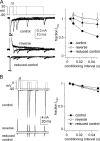Inwardly permeating Na ions generate the voltage dependence of resurgent Na current in cerebellar Purkinje neurons
- PMID: 20410115
- PMCID: PMC2865843
- DOI: 10.1523/JNEUROSCI.0376-10.2010
Inwardly permeating Na ions generate the voltage dependence of resurgent Na current in cerebellar Purkinje neurons
Abstract
Voltage-gated Na channels of cerebellar Purkinje neurons express an endogenous open-channel blocking protein. This blocker binds channels at positive potentials and unbinds at negative potentials, generating a resurgent Na current and permitting rapid firing. The macroscopic voltage dependence of resurgent current raises the question of whether the blocker directly senses membrane potential or whether voltage dependence is conferred indirectly. Because we previously found that inwardly permeating Na ions facilitate dissociation of the blocker, we measured voltage-clamped currents in different Na gradients to test the role of permeating ions in generating the voltage dependence of unblock. In reverse gradients, outward resurgent currents were tiny or absent, suggesting that unblock normally requires "knockoff" by Na. Inward resurgent currents at strongly negative potentials, however, were larger in reverse than in control gradients. Moreover, occupancy of the blocked state was prolonged both in reverse gradients and in control gradients with reduced Na concentrations, indicating that block is more stable when inward currents are small. Accordingly, reverse gradients shifted the voltage dependence of block, such that resurgent currents were evoked even after conditioning at negative potentials. Additionally, in control gradients, peak resurgent currents decreased linearly with driving force during the conditioning step, suggesting that the stability of block varies directly with inward Na current amplitude. Thus, the voltage dependence of blocker unbinding results almost entirely from repulsion by Na ions occupying the external pore. The lack of voltage sensitivity of the blocking protein suggests that the blocker's binding site lies outside the membrane field, in the permeation pathway.
Figures




Similar articles
-
Resurgent current in context: Insights from the structure and function of Na and K channels.Biophys J. 2024 Jul 16;123(14):1924-1941. doi: 10.1016/j.bpj.2023.12.016. Epub 2023 Dec 21. Biophys J. 2024. PMID: 38130058 Free PMC article. Review.
-
A role for phosphorylation in the maintenance of resurgent sodium current in cerebellar purkinje neurons.J Neurosci. 2002 Apr 15;22(8):3100-7. doi: 10.1523/JNEUROSCI.22-08-03100.2002. J Neurosci. 2002. PMID: 11943813 Free PMC article.
-
Resurgent Na currents in four classes of neurons of the cerebellum.J Neurophysiol. 2004 Nov;92(5):2831-43. doi: 10.1152/jn.00261.2004. Epub 2004 Jun 22. J Neurophysiol. 2004. PMID: 15212420
-
Control of transient, resurgent, and persistent current by open-channel block by Na channel beta4 in cultured cerebellar granule neurons.Proc Natl Acad Sci U S A. 2010 Jul 6;107(27):12357-62. doi: 10.1073/pnas.1005633107. Epub 2010 Jun 21. Proc Natl Acad Sci U S A. 2010. PMID: 20566860 Free PMC article.
-
Resurgent current of voltage-gated Na(+) channels.J Physiol. 2014 Nov 15;592(22):4825-38. doi: 10.1113/jphysiol.2014.277582. Epub 2014 Aug 28. J Physiol. 2014. PMID: 25172941 Free PMC article. Review.
Cited by
-
Transient sodium current at subthreshold voltages: activation by EPSP waveforms.Neuron. 2012 Sep 20;75(6):1081-93. doi: 10.1016/j.neuron.2012.08.033. Neuron. 2012. PMID: 22998875 Free PMC article.
-
A Reinterpretation of the Relationship Between Persistent and Resurgent Sodium Currents.bioRxiv [Preprint]. 2024 Jun 1:2023.10.25.564042. doi: 10.1101/2023.10.25.564042. bioRxiv. 2024. Update in: J Neurosci. 2024 Jul 17;44(29):e2396232024. doi: 10.1523/JNEUROSCI.2396-23.2024. PMID: 38187680 Free PMC article. Updated. Preprint.
-
Antagonism of lidocaine inhibition by open-channel blockers that generate resurgent Na current.J Neurosci. 2013 Mar 13;33(11):4976-87. doi: 10.1523/JNEUROSCI.3026-12.2013. J Neurosci. 2013. PMID: 23486968 Free PMC article.
-
Effects of FGF14 and NaVβ4 deletion on transient and resurgent Na current in cerebellar Purkinje neurons.J Gen Physiol. 2019 Nov 4;151(11):1300-1318. doi: 10.1085/jgp.201912390. Epub 2019 Sep 26. J Gen Physiol. 2019. PMID: 31558566 Free PMC article.
-
Resurgent current in context: Insights from the structure and function of Na and K channels.Biophys J. 2024 Jul 16;123(14):1924-1941. doi: 10.1016/j.bpj.2023.12.016. Epub 2023 Dec 21. Biophys J. 2024. PMID: 38130058 Free PMC article. Review.
References
-
- Afshari FS, Ptak K, Khaliq ZM, Grieco TM, Slater NT, McCrimmon DR, Raman IM. Resurgent Na currents in four classes of neurons in the cerebellum. J Neurophysiol. 2004;92:2831–2843. - PubMed
-
- Aldrich RW, Corey DP, Stevens CF. A reinterpretation of mammalian sodium channel gating based on single channel recording. Nature. 1983;306:436–441. - PubMed
Publication types
MeSH terms
Substances
Grants and funding
LinkOut - more resources
Full Text Sources
